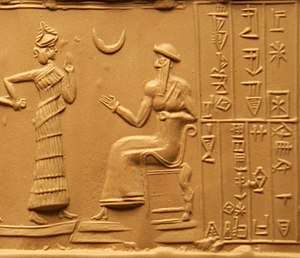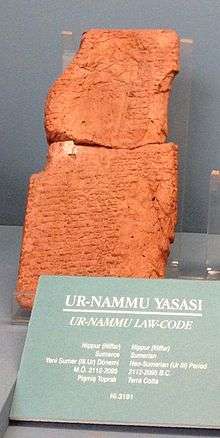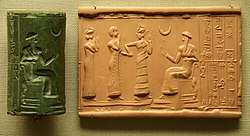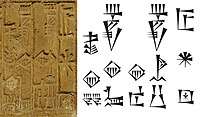Ur-Nammu
Ur-Nammu (or Ur-Namma, Ur-Engur, Ur-Gur, Sumerian: 𒌨𒀭𒇉, ruled c. 2112 BC – 2095 BC middle chronology, or possibly ca. 2047–2030 BC short chronology) founded the Sumerian Third Dynasty of Ur, in southern Mesopotamia, following several centuries of Akkadian and Gutian rule. His main achievement was state-building, and Ur-Nammu is chiefly remembered today for his legal code, the Code of Ur-Nammu, the oldest known surviving example in the world. He held the titles of "King of Ur, and King of Sumer and Akkad".
| Ur-Nammu 𒌨𒀭𒇉 | |
|---|---|
 | |
| King of the Neo-Sumerian Empire | |
| Reign | c. 2112 BC – 2095 BC |
| Predecessor | Utu-hengal |
| Successor | Shulgi |
| Consort | Daughter of Utu-hengal |
| Issue | Shulgi |
| Dynasty | 3rd Dynasty of Ur |
| Religion | Sumerian religion |

.jpg)
𒀭𒈹 Dinanna.... "For Inanna-"
𒎏𒂍𒀭𒈾 Nin-e-an-na.... "Ninanna,"
𒎏𒀀𒉌 NIN-a-ni.... "his Lady"
𒌨𒀭𒇉 UR-NAMMU.... "Ur-Nammu"
𒍑𒆗𒂵 NITAH KALAG ga.... "the mighty man"
𒈗𒋀𒀊𒆠𒈠 LUGAL URIM KI ma.... "King of Ur"
𒈗𒆠𒂗𒄀𒆠𒌵𒆤 LUGAL ki en gi ki URI ke.... "King of Sumer and Akkad"
Reign
According to the Sumerian King List, Ur-Nammu reigned for 18 years.[4] Year-names are known for 17 of these years, but their order is uncertain. One year-name of his reign records the devastation of Gutium , while two years seem to commemorate his legal reforms ("Year in which Ur-Nammu the king put in order the ways (of the people in the country) from below to above", "Year Ur-Nammu made justice in the land").[5]
Among his military exploits were the conquest of Lagash and the defeat of his former masters at Uruk. He was eventually recognized as a significant regional ruler (of Ur, Eridu, and Uruk) at a coronation in Nippur, and is believed to have constructed buildings at Nippur, Larsa, Kish, Adab, and Umma. He was known for restoring the roads and general order after the Gutian period.[6] It is now known that the reign of Puzur-Inshushinak in Elam overlapped with that of Ur-Nammu.[7] Ur-Nammu, who styled himself "King of Sumer and Akkad" is probably the one who, early in his reign, reconquered the territories of central and northern Mesopotamia that had been occupied by Puzur-Inshushinak, possibly at the expense of the Gutians, before going on to conquer Susa.[8]
Ur-Nammu was also responsible for ordering the construction of a number of ziggurats, including the Great Ziggurat of Ur.[9]
He was killed in a battle against the Gutians after he had been abandoned by his army.[6] He was deified, and succeeded by his son Shulgi.[4] His death in battle was commemorated in a long Sumerian elegiac composition, "The Death of Ur-Nammu".[6][10][11]
Year names of Ur-Nammu
Several of the year names of Ur-Nammu are known, documenting the major events of his reign. The main year names are:
Year: "Ur-Namma (is) King"
Year: "Ur-Namma declared an amnesty (misharum) in the land"
Year: "The wall of Ur was built"
Year: "The king received kingship from Nippur"
Year: "The temple of Nanna was built"
Year: "The 'A-Nintu' canal was dug"
Year: "The land of Guti was destroyed"
Year: "The god Lugal-bagara was brought into his temple"— Main year names of the reign of Ur-Nammu.[12]
Artifacts

 Mud-brick stamped with the name of king Ur-Nammu. Using a marker pen, Nippur was written in Arabic at one of the corners; therefore, this brick might well have been found in Nippur. Neo-Sumerian Period. Erbil Civilization Museum, Iraqi Kurdistan.
Mud-brick stamped with the name of king Ur-Nammu. Using a marker pen, Nippur was written in Arabic at one of the corners; therefore, this brick might well have been found in Nippur. Neo-Sumerian Period. Erbil Civilization Museum, Iraqi Kurdistan. Cylinder seal of Ur-Nammu. British Museum.[13]
Cylinder seal of Ur-Nammu. British Museum.[13].jpg) Name of Ur-Nammu on a seal, and standard cuneiform
Name of Ur-Nammu on a seal, and standard cuneiform "Ur-Nammu, King of Ur, and King of Sumer and Akkad" (𒌨𒀭𒇉: Ur-Nammu 𒈗𒋀𒀊𒆠: Lugal Urimki 𒈠: ma 𒈗𒆠𒂗𒄀: Lugal Kiengir 𒆠𒌵: Kiuri)
"Ur-Nammu, King of Ur, and King of Sumer and Akkad" (𒌨𒀭𒇉: Ur-Nammu 𒈗𒋀𒀊𒆠: Lugal Urimki 𒈠: ma 𒈗𒆠𒂗𒄀: Lugal Kiengir 𒆠𒌵: Kiuri) Foundation figure in the form of a peg surmounted by the bust of King Ur-Nammu.
Foundation figure in the form of a peg surmounted by the bust of King Ur-Nammu.
See also
Notes
- 𒌨𒀭𒇉 URDNAMMU / 𒍑𒆗𒂵 NITAH KALAG ga / 𒈗𒋀𒀊𒆠𒈠 LUGAL URIM KI ma.
- "Hash-hamer Cylinder seal of Ur-Nammu". British Museum.
- Enderwitz, Susanne; Sauer, Rebecca (2015). Communication and Materiality: Written and Unwritten Communication in Pre-Modern Societies. Walter de Gruyter GmbH & Co KG. p. 28. ISBN 978-3-11-041300-7.
- Thorkild Jacobsen, The Sumerian King List (Chicago: University of Chicago Press, 1939),pp. 122f
- Year-names for Ur-Nammu
- Hamblin, William J., Warfare in the Ancient Near East to 1600 BC (New York: Routledge, 2006).
- Wilcke; See Encyclopedia Iranica articles AWAN, ELAM
- Steinkeller, Piotr. Puzur-Inˇsuˇsinak at Susa: A Pivotal Episode of Early Elamite History Reconsidered. pp. 298–299.
- "The ziggurat (and temple?) of Ur-Nammu". Archived from the original on 2007-07-08. Retrieved 2007-07-08.
- Shipp, R. Mark (2002). Of Dead Kings and Dirges: Myth and Meaning in Isaiah 14:4b-21. BRILL. pp. 61–63. ISBN 978-90-04-12715-9.
- Kramer, Samuel Noah (1967). "The Death of Ur-Nammu and His Descent to the Netherworld". Journal of Cuneiform Studies. 21: 104–122. doi:10.2307/1359365. ISSN 0022-0256. JSTOR 1359365.
- "Year names of Ur-Nammu".
- "Hash-hamer Cylinder seal of Ur-Nammu". British Museum.
External links
| Wikiquote has quotations related to: Ur-Nammu |
| Wikimedia Commons has media related to Ur-Nammu. |
- Site drawings of the temple built by Ur-Nammu at Ur to the moon god Nanna.
- Nabonidus dedication to the Ziggurat
- The Code of Ur-Nammu at Britannica
- Foundation Figurine of King Ur-Nammu at the Oriental Institute of Chicago
- The "Ur-Nammu" Stela. Penn Museum. 2006. ISBN 978-1-931707-89-3.
- The face of Ur-Namma. A realistic statue of Ur-Namma shows us how he may have looked.
- A brief description of the reign of Ur-Namma.
- I am Ur-Namma. The life and death of Ur-Namma, as told in Babylonian literature.
| Regnal titles | ||
|---|---|---|
| Preceded by Utu-hengal (Fifth dynasty of Uruk) |
King of Ur, Sumer and Akkad ca. 21st century BCE |
Succeeded by Shulgi |